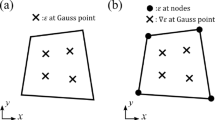Abstract
Domain switching around electrically permeable and impermeable cracks in ferroelectric single crystals subjected to a mechanical load is investigated by using a phase field model. It is found that the electrical boundary conditions have little effect on the polarization distribution without any external load when the initial polarization is parallel to the crack, which is totally different from previous studies where the initial polarization is perpendicular to the crack. However, the simulation results show that the electrical boundary conditions have great influence on the polarization distribution as well as the domain switching behavior when a mechanical load is applied. The critical mechanical load of domain switching with a permeable crack is much smaller than that in the case of an impermeable crack.
Similar content being viewed by others
References
Park, S. and Sun, C., Facture criteria for piezoelectric ceramics. Journal of the American Ceramic Society, 1995, 78(6): 1475–1480.
Fu, R. and Zhang, T., Effects of an electric field on the fracture toughness of poled lead zirconate titanate ceramics. Journal of the American Ceramic Society, 2000, 83(5): 1215–1218.
Suo, Z., Kuo, C.M., Barnett, D.M. and Willis, J.R., Fracture mechanics for piezoelectric ceramics. Journal of the Mechanics and Physics of Solids, 1992, 40(4): 739–765.
Gao, H.J., Zhang, T.Y. and Tong, P., Local and global energy release rates for an electrically yielded crack in a piezoelectric ceramic. Journal of the Mechanics and Physics of Solids, 1997, 45(4): 491–510.
Wang, J. and Zhang, T.Y., Phase field simulations of polarization switching-induced toughening in ferroelectric ceramics. Acta Materialia, 2007, 55(7): 2465–2477.
Zhang, T.Y., Zhao, M.H. and Tong, P., Fracture of piezoelectric ceramics. Advances in Applied Mechanics, 2002, 38: 147–289.
Hao, T.H. and Shen, Z.Y., A new electric boundary condition of electric fracture mechanics and its application. Engineering Fracture Mechanics, 1994, 47(6): 793–802.
Landis, C.M., Energetically consistent boundary conditions for electromechanical fracture. International Journal of Solids and Structures, 2004, 41(22–23): 6291–6315.
Gruebner, O., Kamlah, M. and Munz, D., Finite element analysis of cracks in piezoelectric materials taking into account the permittivity of the crack medium. Engineering Fracture Mechanics, 2003, 70(11): 1399–1413.
Ricoeur, A., Enderlein, M. and Kuna, M., Calculation of the J-integral for limited permeable cracks in piezoelectrics. Archive of Applied Mechanics, 2005, 74(8): 536–549.
Hwang, S., Lynch, C. and McMeeking, R., Ferroelectric/ferroelastic interactions and a polarization switching model. Acta Metallurgica et Materialia, 1995, 43(5): 2073–2084.
Huber, J., Fleck, N., Landis, C. and McMeeking, R., A constitutive model for ferroelectric polycrystals. Journal of the Mechanics and Physics of Solids, 1999, 47(8): 1663–1697.
Kamlah, M. and Tsakmakis, C., Phenomenological modeling of the non-linear electromechanical coupling in ferroelectrics. International Journal of Solids and Structures, 1999, 36(5): 669–695.
Mehling, V., Tsakmakis, C. and Gross, D., Phenomenological model for the macroscopical material behavior of ferroelectric ceramics. Journal of the Mechanics and Physics of Solids, 2007, 55(10): 2106–2141.
Wang, J., Shi, S., Chen, L., Li, Y. and Zhang, T., Phase field simulations of ferroelectric/ferroelastic polarization switching. Acta Materialia, 2004, 52(3): 749–764.
Schrade, D., Mueller, R., Xu, B. and Gross, D., Domain evolution in ferroelectric materials: A continuum phase field model and finite element implementation. Computer Methods in Applied Mechanics Engineering, 2007, 196(41–44): 4365–4374.
Su, Y. and Landis, C., Continuum thermodynamics of ferroelectric domain evolution: Theory, finite element implementation, and application to domain wall pinning. Journal of the Mechanics and Physics of Solids, 2007, 55(2): 280–305.
Wang, J. and Zhang, T.Y., Phase field simulations of a permeable crack parallel to the original polarization direction in a ferroelectric mono-domain. Engineering Fracture Mechanics, 2008, 75(17): 4886–4897.
Song, Y.C., Soh, A.K. and Ni, Y., Phase field simulation of crack tip domain switching in ferroelectrics. Journal Physics D: Applied Physics, 2007, 40(4): 1175–1182.
Li, W.Y. and Landis, C.M., Nucleation and growth of domains near crack tips in single crystal ferroelectrics. Engineering Fracture Mechanics, 2011, 78(7): 1505–1513.
Wang, J. and Kamlah, M., Effect of electrical boundary conditions on the polarization distribution around a crack embedded in a ferroelectric single domain. Engineering Fracture Mechanics, 2010, 77(18): 3658–3669.
Fang, D.L. and Liu, J.X., Fracture Mechanics of Piezoelectric and Ferroelectric Solids. Beijing: Tsinghua University Press, 2008 (in Chinese).
Author information
Authors and Affiliations
Corresponding author
Additional information
Project supported by the National Natural Science Foundation of China (Nos. 10832009, 11002123 and 11090333), the Zhejiang Provincial Natural Science Foundation under grant R6110115, the Chinese Universities Scientific Fund under grant 2009QNA4035 and the program of Key Team of Technological Innovation of Zhejiang Province under grant 2011R09025-07.
Rights and permissions
About this article
Cite this article
Qiao, H., Wang, J. & Chen, W. Phase Field Simulation of Domain Switching in Ferroelectric Single Crystal with Electrically Permeable and Impermeable Cracks. Acta Mech. Solida Sin. 25, 1–8 (2012). https://doi.org/10.1016/S0894-9166(12)60001-9
Received:
Revised:
Published:
Issue Date:
DOI: https://doi.org/10.1016/S0894-9166(12)60001-9




